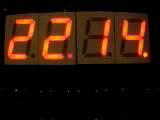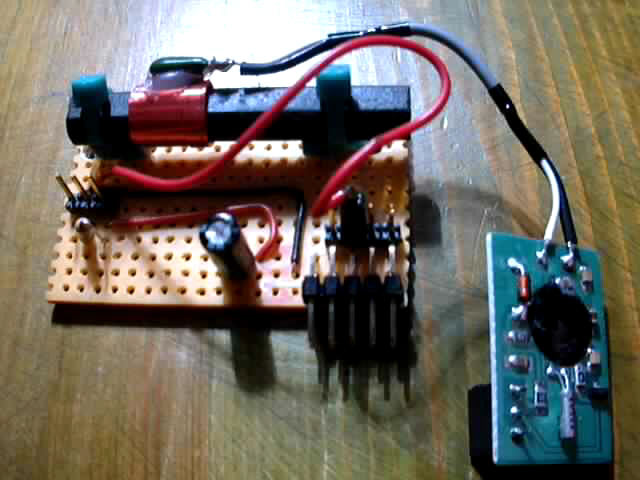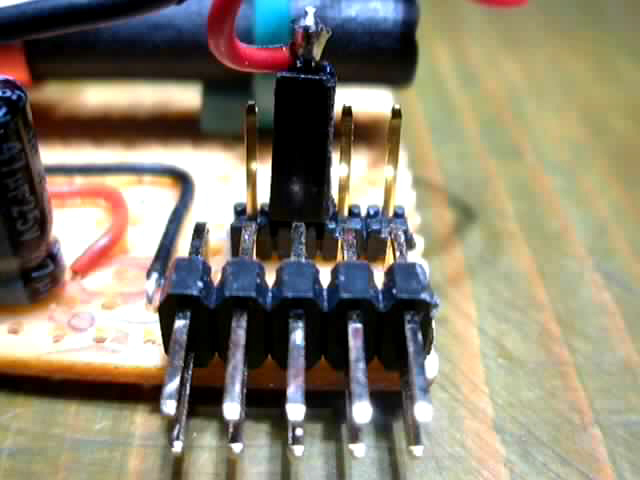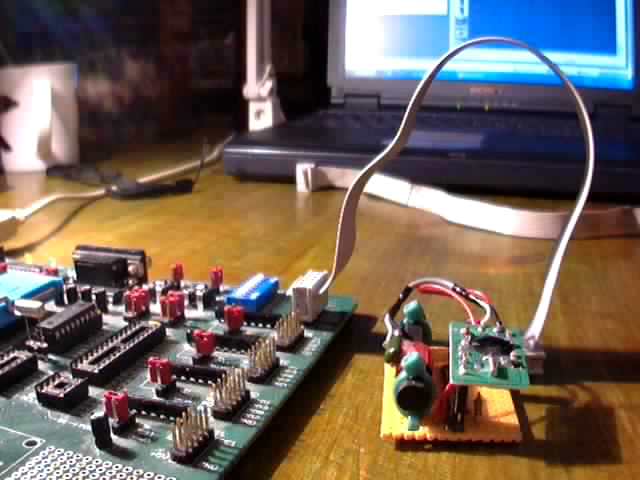
This section will show you how to build this clock :

and make it run on a EasyPic development circuit board.
The complete schematic, and the C language source code is freely provided !
1. What is DCF77 ?
DCF77 is the name of a german radio station on 77.5 KHz, which gives official time and date from an atomic clock located in Francfort. The time and date is coded into a 59 bit length frame, and is sent on the air through an antenna, by a 50 kilowatt power amplifier.
A simple and tiny receiver can catch the signal, from approximately 2000 kilometers around the antenna. The pulse contained in the radio frequency signal is filtered by the receiver : a 100 ms pulse is a value of 0, a 200 ms pulse is a value of 1, there is a pulse per second, and the last second of a minute lacks (there is 2 seconds without pulse) to allow synchronisation with the next minute.
There are many good web sites about DCF77, I strongly recommend to visit the official DCF77 web site :
http://www.dcf77.com/ (German language)
it contains all that you have to know about DCF-77. You can also try a Google search on DCF77 and select the most appropriate result for your convenience.
2. How to build a DCF77 receiver ?
You don't need to build yourself a DCF77 receiver : there are ready-made, cheap modules to buy on internet, ask also your local dealer.
I tried a few ones, their costs vary from 12 € to 18 €, all work very well.
You will have to refer to the datasheet that comes with it, to connect it properly. They have 3 pins :
Some of them are using positive logic (the pulse is a rising edge from 0 volt to the voltage power supply, followed by a falling edge to 0 volt), others are using negative logic (the pulse is a falling edge from the voltage power supply to 0 volt, and a rising edge to the voltage power supply). Don't worry about this : the software of the clock handles the both of them ! You will just have to add a pull-up resistor on the pulse output in case of negative logic.
The one used for this project, has been bought to my Electronic Diffusion local dealer for a cost of 15 € (negative logic).
3. My DCF77 board
Once the DCF77 module in hand, you will note how fragile is it !
First, You will have to mount it on a rigid circuit board, otherwise its tiny circuit board will break from the antenna quickly.
This is how I managed to build my circuit board :

On this picture you can see :
This is a close-up picture of the connectors :

The 2 x 5 male pins will be connected to the EasyPic circuit board : it matches exactly its layout, so that an simple flat cable will allow to connect the two circuit boards.
This is the pinout description of the connector :
| Pin number, from left to right | 1 | 2 | 3 | 4 | 5 |
| Upper line | +5V | bit #6 | bit #4 | bit #2 | bit #0 |
| Lower line | Gnd | bit #7 | bit #5 | bit #3 | bit #1 |
Behind, we can see 4 pins : they are facing and connected to the pins 0, 2, 4, 6 of the connector, so that it is possible to choose the even io pin number of the microcontroller port, on which we want the DCF77 signal pulse to be connected. Just adjust it with the female socket, it is connected to the output of the receiver on its other extremity.
This is my circuit board, ready to be connected to the EasyPic circuit board :
As you can see, the output pulse of the receiver is wired to bit #4 of the microcontroller port.
The ferrit stick must be perpendicular to Francfort direction, to have the best radio signal quality.
Here is the receiver circuit board, connected to the EasyPic circuit board :

As you can see, the receiver is connected to the PORT A of the microcontroller.
At this time, the DCF77 hardware of the project is ready !
Here is the equivalent circuit schematic (clic to enlarge) :
4. EasyPic setup
This section will be very short ! Here is what you have to do :
That's all !
5. Write the PIC
It's time to write the program into the PIC !
Here is the .HEX file : download it, read it in the PICFLash programmer and write it !
DOWNLOAD DCF77 LED CLOCK .HEX FILE (5,47 Ko)
6. It runs ! How to use it ?
First, you will have to adjust the orientation of the ferrit stick, perpendicularly to the direction of Francfort, in order to have a radio signal as strong as possible.
The DCF77 pulse is shown on the decimal point of the second LED display unit : when the receiver is correctly turned, the LED of the decimal point must flash regularly. Adjust the orientation if it is not good.
You may also have to turn off all devices that could perturb the radio waves : TV set, cellular or wireless phones, computer and screen display, and so on, until you will get a good signal pulse. The 2 digits of the right will then increment each second : the clock is waiting for a complete DCF77 frame.
Watch the video :
The display has two different modes, which depend on the clock state :
Clock not locked :
Clock locked :
7. The source code
You can find here the DCF77 LED CLOCK C SOURCE CODE : just copy and paste it in the MikroC compiler.
Adjust the initial value of the variable 'mode', depending on the kind of logic of the DCF77 receiver you have.
The program uses 861 bytes of ROM, and 62 bytes of RAM.